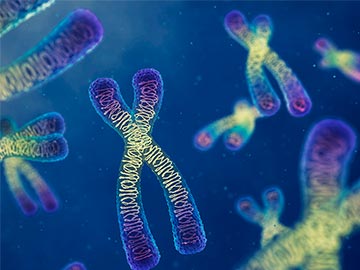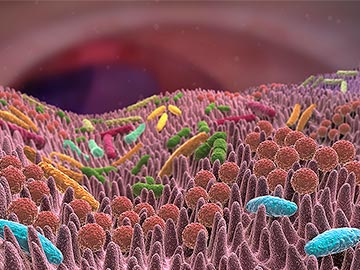Ulcerative Colitis (UC)
The onset of UC occurs in young adults between 20 and 40 years old, and it increases by 3000 new cases every year.
Medicine can deal with the symptoms, but could not yet identify the cause of the disease or find a definite treatment.
Definition
Ulcerative colitis is one of the inflammatory bowel diseases (IBDs). It is characterized by continuous lesions, mostly superficial, that appear on the rectum and can extend to the whole colon without affecting other parts of the digestive tract.
It progresses in phases with intermittent remissions (dormant, asymptomatic periods). It may be accompanied by extra-intestinal symptoms (articular, cutaneous, hepatic, etc.)
Epidemiology

It is very common in industrialized countries - Northwestern Europe and the United States. With almost 3000 new cases every year, France is the least affected. The disease usually begins between 30 and 40 years old.
Unlike Crohn's disease, this condition affects mostly non-smokers, as tobacco (through mechanisms that remain unknown to this date, but are not related to nicotine) protects from UC.
Appendectomy (in childhood) also has a protective effect.
Symptoms: pain and severity
The most frequently observed symptom in UC is the presence of blood in stools (rectorrhagias). It may be associated with mucus discharges, diarrhea, abdominal pains, etc. Severe flare-ups may result in weight loss, severe fatigue and fever.
In almost one third of cases, the disease starts with lesions limited to the rectum, while one third of the patients experience inflammation of the whole large intestine from the start (pancolitis). After 20 years of progression, this pancolitic form of the disease is found in 50% of the patients.
Extra-intestinal symptoms may appear: in the joints (arthralgia, low back pain), on the skin (erythema nodosum), sometimes in the eyes or the liver.
In children, ulcerative colitis leads to malnutrition, which may cause severe failure to thrive.
A number of not rare and sometimes inaugural complications add burden to the medical and surgical care of these patients: severe colitis, fistula, stenosis, cancerous degeneration with a risk 18 times higher than in general population after 20 years of progression of a pancolitic form of the disease.
IBDs, a scientific puzzle...
he chronic inflammation of the digestive tract characterizing IBDs appears to be the consequence of an abnormal immune response of the bowel to intestinal flora components in genetically predisposed subjects, due to environmental factors.
Genetic Susceptibility

Such susceptibility has been suggested for many years in light of the high number of patients in specific ethnic groups, the rare association with genetic diseases and especially the observation of family cases (where similarities in disease presentation are frequent) and the concordance of disease in twins.
Since 2001, when the first susceptibility gene for this disease was identified (NOD2/CARD15 on chromosome 16), nearly a hundred of other genes have been highlighted. Considering the frequency of these diseases, the absolute risk for 1st degree relatives (father, mother, siblings, children) to get the disease amounts to approximately 1% (vs. 0.1% in the general population) and up to 6% when several siblings are affected. However, there is so far no indication for a genetic investigation.
The role of these risk genes, their interactions and the consequences of their mutations are researched intensively, but their burden in the pathophysiology of IBDs remain moderate and IBDs are never hereditary diseases.
Immune System Disorder
It is characterized by abnormalities of the innate immune response and of the specific immune response: Innate immune response is the first non-specific and immediate line of defense of the body. A whole series of mechanisms are involved, including increased intestinal permeability, particularly to bacteria of the digestive tract, which are then able to cause inflammation and attract immune cells to the gut wall.
These specialized immune cells will trigger a specific response against the components of the patient's own intestinal flora, thus causing persistent inflammation of the small intestine or the colon.
The Environmental Factor
Variations of IBD incidence (number of new cases per year) and prevalence (number of persons affected) over time and space suggest a major environmental factor. IBDs are primarily environmental diseases. Epidemiology shows a higher incidence in industrialized countries and an increasing incidence in westernizing countries. This would imply that certain environmental factors, probably associated with the western lifestyle, might have a major influence on the development of this disease.
The study of migrating populations is particularly interesting and has clearly demonstrated that certain populations with an initially low incidence have seen this measure increase rapidly to match the one of their host country, thus illustrating the importance of lifestyle in the onset of these diseases.
Many risk factors have been reported. The only ones that have been clearly established so far are tobacco use (the mechanisms remain unknown to this date, but are not related to nicotine) which protects from UC but promotes and aggravates Crohn's disease, and appendectomy (in childhood) which protects from ulcerative colitis.
The Influence of Intestinal Flora

It is now well documented that intestinal flora, or microbiota, plays a key role in IBDs.
This is illustrated by various observations:
- In IBD patients, different bacteria populations are modified (dysbiosis). Potentially pathogenic bacteria (such as Escherichia coli, Listeria monocytogenes, Yersinia enterocolitica and Mycobacterium paratuberculosis) are found in excess amount while beneficial bacteria of the Firmicute group are reduced both in species and proportion.
- The most common localizations of IBDs coincide with areas of the digestive tract with the highest density of bacteria (terminal ileum and colon).
- In patients who had to undergo surgery, the risk of early recurrence is increased when the rate of a certain type of bacteria (Faecalibacterium. prausnitzii) is low.
- In animal models for IBDs, administration of these bacteria or of the molecules released by these bacteria reduced intestinal inflammation and significantly improved survival.
- Similarly, an inflammatory bowel disease did not develop if the animals were maintained in sterile conditions from birth.
All these observations pave the way for new research prospects, the implementation of new diagnostic tools and new hopes for treatment and prevention.
Ulcerative Colitis Therapies
The prime objective of the treatments currently available is to control flare-ups, to prevent recurrences and to maintain optimal quality of life for every patient.
Aminosalicylate derivatives are largely used and have been proven efficient in light to moderate attacks. Their use as a maintenance treatment can sustain remissions. These agents also decrease the risk of developing colorectal cancer. Aminosalicylate suppositories and enemas are more efficient than oral corticosteroids.
Corticosteroids are the basic treatment for moderate to severe intensity attacks. They are used over short periods of time, in order to limit the side effects.
Immunosuppressants have extensively developed. Their action is very targeted towards certain components of the immune system: AZATHOPRINE, 6-MERCATOPURINE and METHOTREXATE are the most commonly prescribed as a maintenance therapy. As their onset of action occurs within a few months, they cannot be used as a monotherapy for the treatment of flare-ups. They are used in progressive forms or challenging treatment. Cyclosporine is also used in severe, corticosteroid resistant forms of the disease, over short periods of time.
Antidiarrheals slow down the travel of foods through the intestine.
Antispasmodics relieve abdominal pains. Their action against spasms focuses on nerve fibers, muscle fibers, or both.
In addition to an appropriate diet, nutritional treatment may prove necessary. Such nutritional assistance may be enteral (through a nasogastric tube) or parenteral (intravenously). However, it is considered only in the case of severe undernutrition or failure to thrive in children or teenagers. Unlike in Crohn's disease, it has no impact on the progression of the disease.
Biotherapies: INFLIXIMAB, called Rémicade in Europe, already used for the treatment of Crohn's disease, was very recently proven efficient for rescue and maintenance therapy in UC.
Surgery treatment is indicated in severe forms, after failure of the medical treatment, in incapacitating chronic forms and in severe acute complications (hemorrhages, perforation, toxic megacolon). Surgery can permanently cure UC.
In case of pancolitis, 40 to 60% of the patients undergo surgery in the first 10 years of the disease course.
Surgical techniques rely on total colectomy, i.e. removal of the entire colon. There are two options available:
- Ileoanal anastomosis: Rectal resection and creation of a reservoir from the small intestine to replace the rectum. In few rare cases, an inflammation of the reservoir, called pouchitis, has been observed and could be treated with antibiotics.
- Ileorectal anastomosis: the rectum is preserved when it is not too damaged and the condition is recent. This technique offers better post-surgery comfort, but there is a risk of disease relapse on the rectum.
Therapeutic protocols: a chance for patients! Despite significant progress over the last few years, the problem is not settled and many patients "escape" their treatment. The purpose of these protocols is to test new therapeutic options, but also to optimize treatment schemes.

